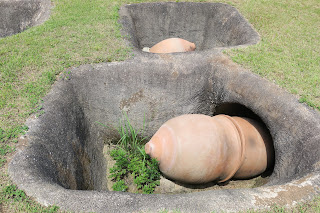Yoshinogari (Yoshinogari iseki) is the name of a large and complex Yayoi archaeological site in Yoshinogari and Kanzaki in Saga Prefecture, Kyushu, Japan.
According to the Yayoi chronology established by pottery seriations in the 20th century, Yoshinogari dates to between the 3rd century BC and the 3rd century AD.
This archaeological site is of great importance in Japanese and world prehistory because of the massive size and important nature of the settlement and the artifacts found there.
Yoshinogari consists of a settlement, a cemetery, and multiple ditch-and-palisade enclosed precincts.
|
Yoshinogari Historical Park map. |
|
Entrance gate. |
|
South inner enclosure (Minami Naikaku). |
|
South Village (Minami no Mura). |
|
North inner enclosure Main shrine (Kita Naikoku). |
|
Yoshinogari leaders discuss important matters. |
|
High priestess receiving a revelation. |
|
Rows of Burial Jars (Kamekan Boretsu).
|
|
Shrine (Shido). |
|
North Burial Mound (Kita Funkyubo).
|
Source
Location
















